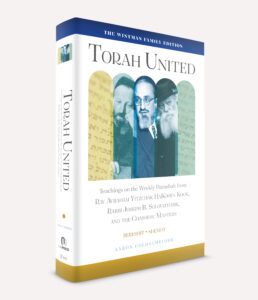Excerpted from Rabbi Aaron Goldscheider’s Torah United: Teachings on the Weekly Parasha from Rav Avraham Yitzchak HaKohen Kook, Rabbi Joseph B. Soloveitchik, and the Chassidic Masters, co-published by OU Press and Ktav Publishing House
 Sarah’s Outcry
Sarah’s Outcry
In the midst of the unspeakable horror that was the Warsaw Ghetto, a holy fire continued to burn bright. This ember was Rebbe Kalonymus Kalman Shapira, the Piasetzner Rebbe, who served as the spiritual leader and father to thousands of adherents until his murder by the Nazis. His powerful sermons of the war years are preserved in Esh Kodesh, a work with an astonishing backstory. When it became apparent to the Piasetzner that the ghetto would be liquidated, he buried the book manuscript in a canister. The canister was miraculously unearthed by Polish construction workers after the war, and the book was first published in Israel in 1960.
In a remarkable teaching, written amidst unfathomable anguish, the Piasetzner Rebbe addressed the great challenge of continued faith in God’s justice in the face of terrifying and agonizing adversity. He began with the opening verse of Parashat Chayei Sarah: “The years of Sarah’s life were one hundred and twenty-seven years, the years of Sarah’s life” (Genesis 23:1). Why the repetitive phrase “the years of Sarah’s life” at the end of the verse?
The rebbe explained that the repetition is a sign of her extreme, lifelong piety which surpassed even Avraham’s. When the years of Avraham’s life are later tallied (Genesis 25:7), there is no such repetition. Sarah’s faith and devotion were unparalleled, even in her final moments on this earth.
The Piasetzner Rebbe quoted Rebbe Menachem Mendel Torem of Rimanov (1745–1815) on the comparison drawn in the Talmud between salt and suffering, based on the Torah’s use of the word berit, “covenant,” with each. Just as salt sweetens the meat by bringing out its flavor, so too suffering sweetens the putrid sins of man. Rebbe Menachem Mendel furthered the analogy. Salt is only a taste enhancer when applied proportionately – too much salt spoils the meat. Similarly, suffering must be diluted with mercy so that it is proportionate and does not crush a person.
Rashi tells us that the juxtaposition of Sarah’s death at the beginning of Parashat Chayei Sarah with the Akedah in Parashat Vayera is indicative of a causal link. Sarah died after hearing that her only son had been bound like a sacrifice and almost slaughtered. In the rebbe’s words:
Our master Moshe, the faithful shepherd, juxtaposed the death of Sarah to Akedat Yitzhak, in order to advocate for us and to demonstrate what happens when there is too much suffering, God forbid: her soul departed. Furthermore, if this could happen to Sarah, so righteous a woman that when she was 100 she was like 20 with regard to sin . . . , and all of Sarah’s years were equivalent for good, yet she could not bear such deep agony, how much more so is this true for all of us.
Even the greatest, most pious Jews of all time were fragile human beings who could be broken by intolerable suffering.
The Piasetzner Rebbe then boldly claimed that Sarah’s death, the result of overwhelming psychological trauma, was an act on behalf of all Jews, as a protest to God, a demonstration that the Jewish people cannot bear excessive suffering. She gave up her life, if you will, in order to “teach the Creator” the limits of human suffering. She chose to show God the effect of suffering when it is too much to bear.
Even someone who on account of God’s compassion survives their suffering, parts of their lifeforce, mind, and spirit are still crushed and obliterated. Does it matter if one is partly dead or fully dead?
This explains why the verse repeats “the years of Sarah’s life.” Sarah cut her life short. She had been allotted more years that would never be lived out, which could be construed as a blot on her piety. Since she acted for the good of her people, however, the final phrase in the verse instructs us that the lost years were like the rest. Her saintliness pervaded them all equally.
This sermon was delivered orally on the Shabbat of Parashat Chayei Sarah, November 4, 1939. Only two months earlier the Rebbe of Piasetzna had suffered one of the most excruciating blows of his life: the deaths of his only son, his daughter-in-law, and his sister-in-law, all killed by the Nazi aerial bombing of Warsaw in September 1939. In speaking of Sarah’s loss, the rebbe’s own tormented voice is audible.
In this gut-wrenching sermon, the rebbe affirmed that crushing heartbreak and psychological pain can be traumatic. In severe cases, a part of us dies. While the classic religious response to suffering is submission, Sarah confronted the Creator, challenging Heaven to be more responsive and compassionate to the evil that man is made to endure. This gesture legitimates, the rebbe seems to say, our wrestling with theodicy. We are permitted – perhaps even obligated – to press God in our search for beacons of truth and justice in the smothering fog of suffering.
The Piasetzner Rebbe concluded his unforgettable sermon with the following prayer: “Therefore, may God have mercy upon us and all Israel, and may He rescue us quickly spiritually and physically, with open kindnesses.” Although wounded more than we can know, the rebbe’s faith remained steadfast, anticipating redemption. We can imagine to ourselves the rebbe turning with humility and deep faith to God in Heaven, his lips forming a heartfelt petition: “I may not understand Your ways, but I will not give up on seeking Your closeness and anticipating the final redemption.” The holy rebbe pleaded for that day to come soon.

